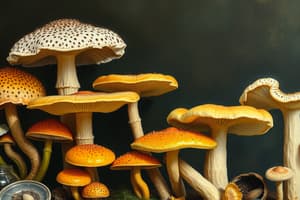Podcast
Questions and Answers
What is the primary distinguishing feature used to classify fungi into yeasts and molds?
What is the primary distinguishing feature used to classify fungi into yeasts and molds?
- Their reproductive methods
- Their morphological characteristics (correct)
- The size of their colonies
- Their nutritional needs
Which of the following best describes the method of reproduction in yeasts?
Which of the following best describes the method of reproduction in yeasts?
- Sexual reproduction only
- Fragmentation
- Spore formation
- Budding or binary fission (correct)
Which type of fungi is primarily responsible for causing diseases like oral thrush?
Which type of fungi is primarily responsible for causing diseases like oral thrush?
- Opportunistic pathogens (correct)
- True pathogens
- Filamentous fungi
- Dimorphic fungi
What are the multicellular structures that make up molds called?
What are the multicellular structures that make up molds called?
At what temperature do dimorphic fungi typically exist in their yeast form?
At what temperature do dimorphic fungi typically exist in their yeast form?
What % of coccidioidomycosis cases is accompanied by cold-like symptoms such as fever and cough?
What % of coccidioidomycosis cases is accompanied by cold-like symptoms such as fever and cough?
Which of the following is a key characteristic of the diagnosis of coccidioidomycosis?
Which of the following is a key characteristic of the diagnosis of coccidioidomycosis?
Which type of infections are dermatophytoses classified under?
Which type of infections are dermatophytoses classified under?
What is the causative agent of blastomycosis?
What is the causative agent of blastomycosis?
Which patients have the highest susceptibility to coccidioidomycosis?
Which patients have the highest susceptibility to coccidioidomycosis?
Flashcards are hidden until you start studying
Study Notes
Fungi as Infectious Agents
- Fungi comprise a kingdom of unicellular and multicellular eukaryotes with distinct morphological, biological, and molecular features.
- They can be saprobes, symbionts, or parasites, playing diverse ecological roles.
Classification of Fungi
- Fungi are categorized into two main groups: yeasts and filamentous fungi (molds).
- Fungal diseases in humans are known as mycoses.
- Fungal pathogens are grouped by virulence and invasion level: systemic, subcutaneous, cutaneous, and superficial.
- Fungi of medical importance are classified as true pathogens or opportunistic pathogens.
Molds
- Multicellular fungi characterized by filamentous structures called hyphae, forming a network known as mycelium.
- Molds reproduce through spores, which can be sexual or asexual, often resulting in fuzzy or powdery colonies.
Yeasts
- Unicellular fungi that reproduce asexually by budding or binary fission, forming smooth, creamy colonies.
- Candida species are common pathogens, causing infections like oral thrush and vaginal yeast infections.
- Cryptococcus neoformans leads to cryptococcosis, primarily affecting the lungs and central nervous system.
Dimorphic Fungi
- These fungi can exist as yeasts or molds, adapting to environmental temperatures (e.g., coccidioides immitis causes Valley fever).
- Approximately 100,000 cases of coccidioidomycosis occur annually, with spores easily inhaled.
Coccidioidomycosis
- Symptoms often include cold-like effects such as fever, cough, and malaise, especially prevalent in AIDS patients.
- Diagnosis involves identifying distinctive spherules in bodily fluids; treatment for severe cases requires amphotericin B.
Blastomyces dermatitidis
- Causes blastomycosis, leading to respiratory symptoms, and potential chronic systemic disease affecting various organs.
Cutaneous Mycoses
- Caused by dermatophytes causing infections in skin, hair, and nails commonly known as ringworm or tineas.
- Communicable infections are supported by moist, chafed skin.
- Treatment includes topical antifungals; severe cases may require griseofulvin or terbinafine.
Pneumocystis jiroveci
- Causes Pneumocystis pneumonia (PCP), a major opportunistic infection in AIDS patients, characterized by severe lung secretions.
- Treatment involves cotrimoxazole, with potential use of pentamidine.
Subcutaneous Mycoses
- Sporothrix schenckii causes sporotrichosis, particularly via skin penetration; it can lead to lymphocutaneous spread.
Opportunistic Mycoses
- Candida albicans causes candidiasis, prevalent in immunocompromised individuals, presenting as oral thrush or vulvovaginal infections.
- Treatment for candidiasis includes topical antifungals, with recurrent cases managed by over-the-counter options.
Cryptococcus neoformans
- Causes significant infections in immunocompromised patients (AIDS, cancer, diabetes), leading to pneumonia and potential CNS dissemination.
- Treatment for systemic infections requires amphotericin B and fluconazole.
Diagnosis of Fungal Infections
- Clinical history, laboratory methods, and various tests (microscopic, culture, serological, molecular) are used for diagnosis.
Laboratory Diagnosis Techniques
- Microscopy: Direct examination and staining (KOH, Calcofluor White, India Ink).
- Culture: Different agar media (SDA, PDA, BHI) encourage fungal growth at varying temperatures.
- Histopathological Examination: Tissue biopsy with specific staining methods (H&E, PAS, GMS) to identify fungi.
Serological Tests
- Detects antibodies or antigens related to fungal infections (e.g., ELISA, cryptococcal antigen test).
Molecular Methods
- PCR techniques amplify fungal DNA for identification; sequencing methods ascertain specific fungal species.
Imaging Techniques
- Radiography (X-rays, CT scans, MRI) helps assess deep infections and their extent.
Studying That Suits You
Use AI to generate personalized quizzes and flashcards to suit your learning preferences.




